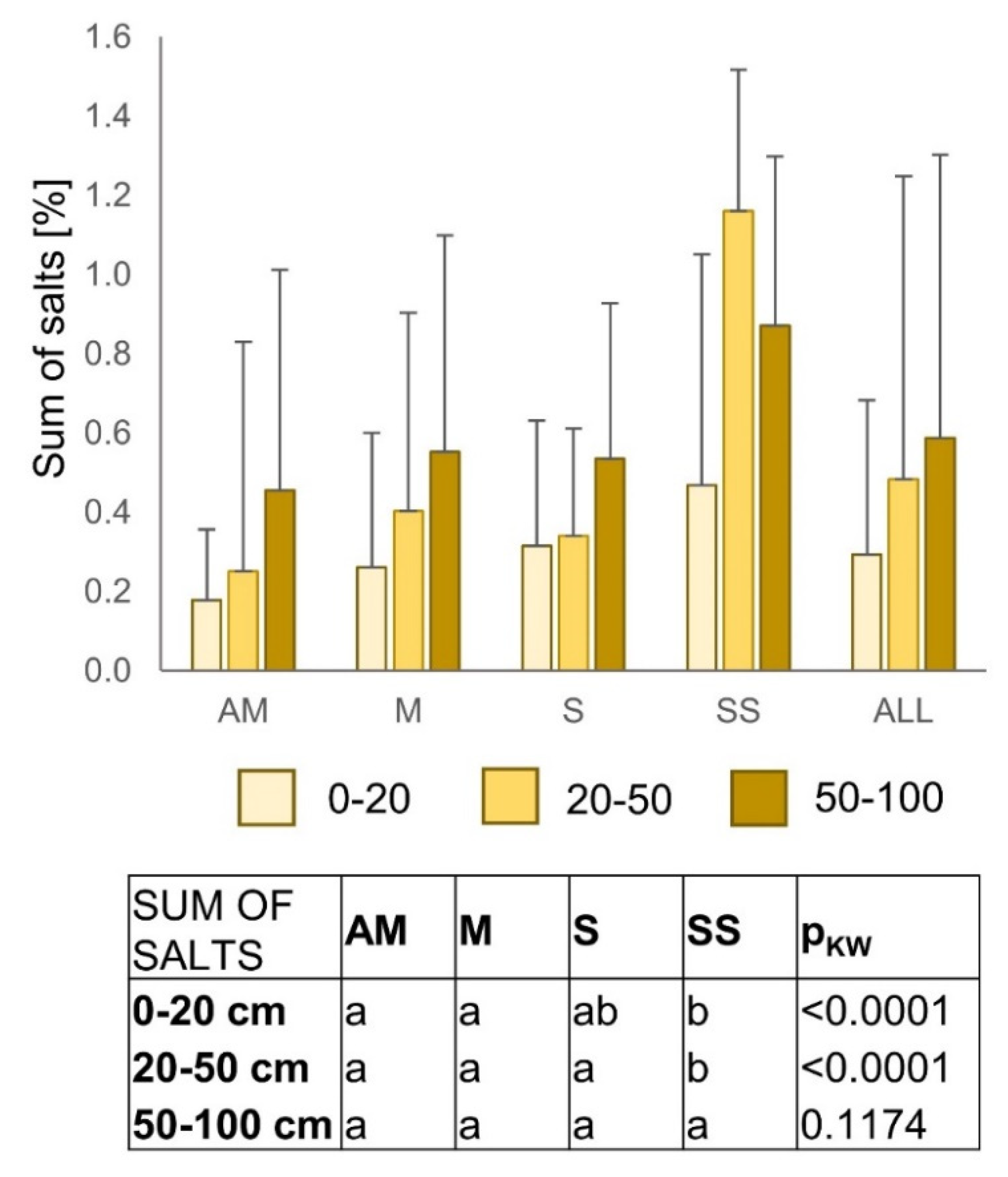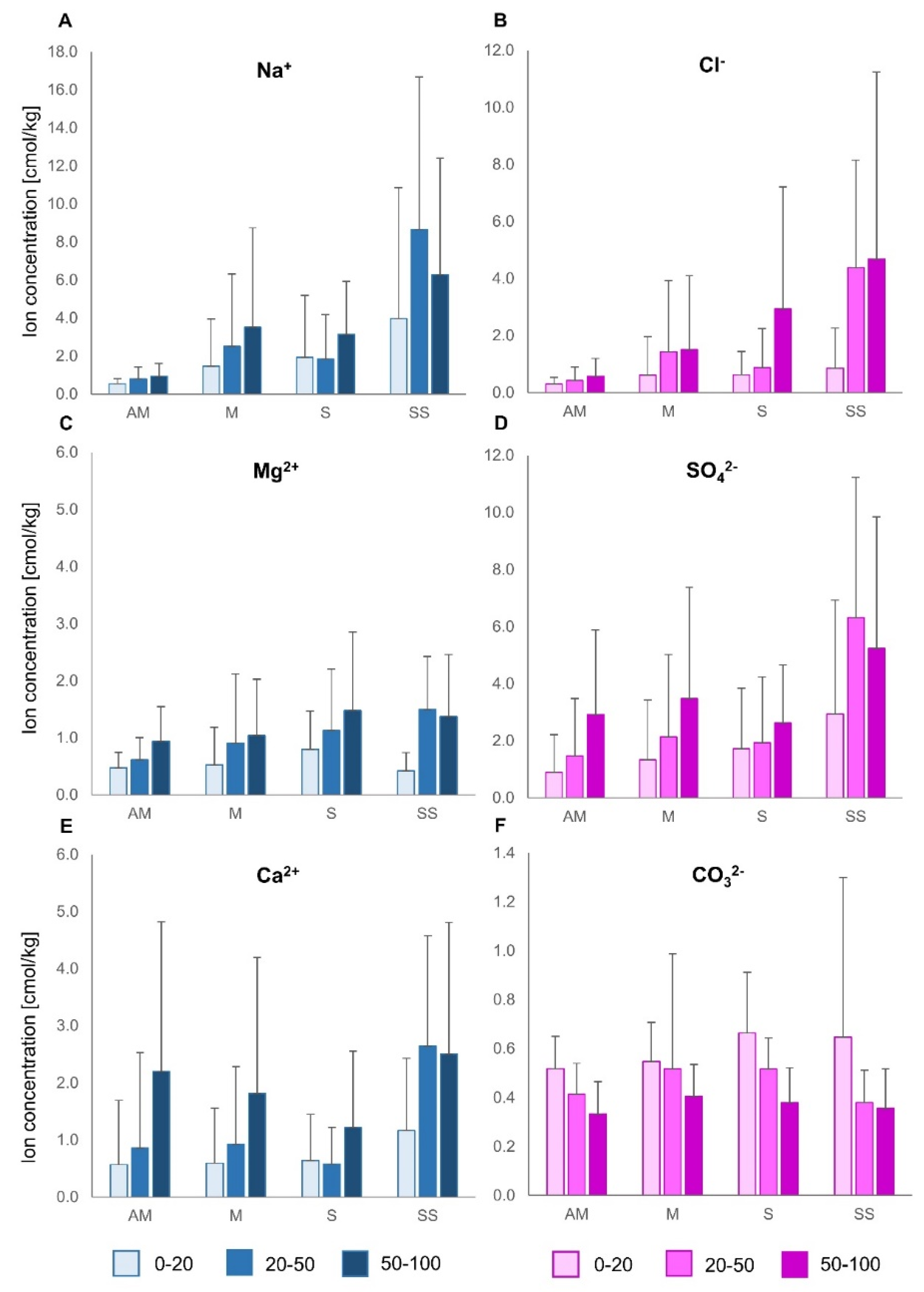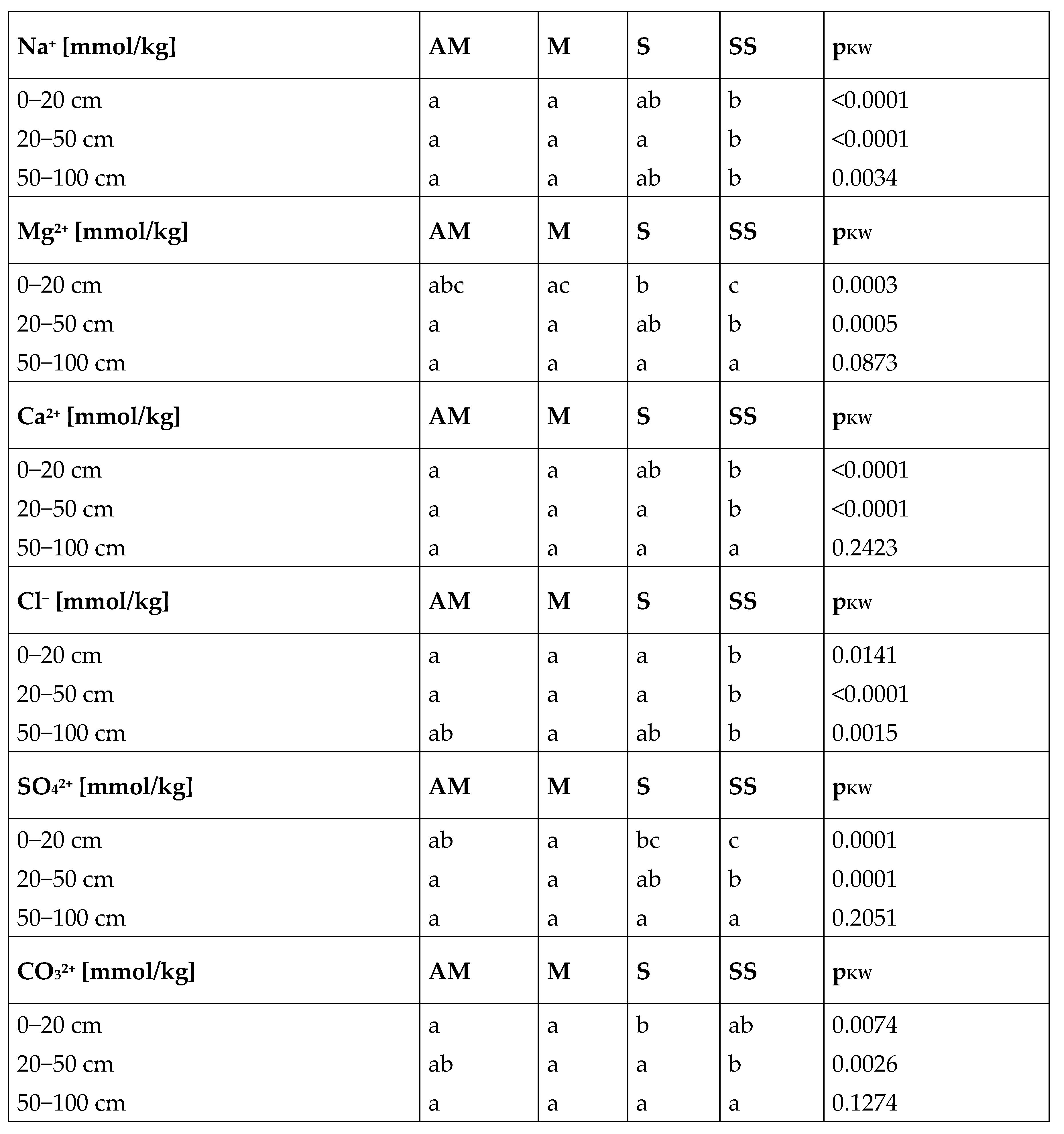Spatial and In-Depth Distribution of Soil Salinity and Heavy Metals (Pb, Zn, Cd, Ni, Cu) in Arable Irrigated Soils in Southern Kazakhstan
Abstract
:1. Introduction
2. Study Sites, Materials and Methods
2.1. Description of the Study Area
2.2. Data Collection
2.2.1. Field Sampling
2.2.2. Laboratory Analyses
2.2.3. Statistical Analyses
3. Results
3.1. Physical and Chemical Characteristics of the Studied Soils
3.2. Soil Salinity
3.3. The Total and Mobile Form Content of Selected Metals in the Studied Soils
3.4. Relationship between Physicochemical Soil Properties, including Soil Salinity and Content of Total and Mobile Forms of Heavy Metals
4. Discussion
4.1. Soli Salinization
4.2. Soil Contamination with Heavy Metals
5. Conclusions
Author Contributions
Funding
Institutional Review Board Statement
Informed Consent Statement
Data Availability Statement
Conflicts of Interest
References
- Issanova, G.T.; Abuduwaili, J.; Mamutov, Z.U.; Kaldybaev, A.A.; Saparov, G.A.; Bazarbaeva, T.A. Saline Soils and Identification of Salt Accumulation Provinces in Kazakhstan. Arid Ecosyst. 2017, 7, 243–250. [Google Scholar] [CrossRef]
- Baubekova, A.; Akindykova, A.; Mamirova, A.; Dumat, C.; Jurjanz, S. Evaluation of Environmental Contamination by Toxic Trace Elements in Kazakhstan Based on Reviews of Available Scientific Data. Environ. Sci. Pollut. Res. 2021, 28, 43315–43328. [Google Scholar] [CrossRef] [PubMed]
- Thomas, D.S.G.; Middleton, N.J. Salinization: New perspectives on a major desertification issue. J. Arid Environ. 1993, 24, 95–105. [Google Scholar] [CrossRef]
- FAO; UN Water. Progress on change in water-use efficiency. In Global Status and Acceleration Needs for SDG Indicator 6.4.1; FAO: Rome, Italy, 2021. [Google Scholar] [CrossRef]
- Zhou, X.; Zhang, Y.; Sheng, Z.; Manevski, K.; Andersen, M.N.; Han, S.; Li, H.; Yang, Y. Did water-saving irrigation protect water resources over the past 40 years? A global analysis based on water accounting framework. Agric. Water Manag. 2021, 249, 106793. [Google Scholar]
- Mueller, L.; Saparov, A.; Lischeid, G. Environmental Science Novel Measurement and Assessment Tools for Monitoring and Management of Land and Water Resources in Agricultural Landscapes of Central Asia; Springer: Cham, Switzerland, 2014. [Google Scholar] [CrossRef]
- Borovsky, V.M. Salt-affected soil development and geochemical provinces of Kazakhstan. (Formirovanie zasolennykh pochv I geochemicheskie provintsii Kazakhstana), Alma Ata. Nauka 1982. [Google Scholar]
- Liu, W.; Ma, L.; Smanov, Z.; Samarkhanov, K.; Abuduwaili, J. Clarifying Soil Texture and Salinity Using Local Spatial Statistics in Kazakh–Uzbekistan Border Area, Central Asia. Agronomy 2022, 12, 332. [Google Scholar] [CrossRef]
- Ma, L.; Abuduwaili, J.; Smanov, Z.; Ge, Y.; Samarkhanov, K.; Saparov, G.; Issanova, G. Spatial and Vertical Variations and Heavy Metal Enrichments in Irrigated Soils of the Syr Darya River Watershed, Aral Sea Basin, Kazakhstan. Int. J. Environ. Res. Public Health 2019, 16, 4398. [Google Scholar] [CrossRef] [Green Version]
- Zhang, W.; Ma, L.; Abuduwaili, J.; Ge, Y.; Issanova, G.; Saparov, G. Hydrochemical Characteristics and Irrigation Suitability of Surface Water in the Syr Darya River, Kazakhstan. Environ. Monit. Assess. 2019, 191, 572. [Google Scholar] [CrossRef] [Green Version]
- Otarov, A.; Ibrayeva, M.A.; Saparov, A.S. Degradation processes and modern soil-ecological state of rice massifs in the republic: Ecological Bases of Soil Surface Formation of Kazakhstan in Conditions of Anthropogenesis, and Development of Theoretical Bases of Fertility Reproduction. Almaty 2007, 73–104. [Google Scholar]
- Otarov, A. Concentration of Heavy Metals in Irrigated Soils in Southern Kazakhstan. In Environmental Science Novel Measurement and Assessment Tools for Monitoring and Management of Land and Water Resources in Agricultural Landscapes of Central Asia; Springer: Cham, Switzerland, 2014; pp. 641–652. [Google Scholar] [CrossRef]
- Sommer, R.; Glazirina, M.; Yuldashev, T.; Otarov, A.; Ibraeva, M.; Martynova, L.; Bekenov, M. Impact of Climate Change on Wheat Productivity in Central Asia. Agric. Ecosyst. Environ. 2013, 178, 78–99. [Google Scholar] [CrossRef]
- Laiskhanov, S.U.; Azimbay Otarov, A.; Savin, I.Y.; Tanirbergenov, S.I.; Mamutov, Z.U.; Duisekov, S.N.; Zhogolev, A. Dynamics of Soil Salinity in Irrigation Areas in South Kazakhstan. Pol. J. Environ. Stud. 2016, 25, 2469–2476. [Google Scholar] [CrossRef]
- Suska-Malawska, M.; Sulwiński, M.; Wilk, M.; Otarov, A.; Mętrak, M. Potential Eolian Dust Contribution to Accumulation of Selected Heavy Metals and Rare Earth Elements in the Aboveground Biomass of Tamarix Spp. from Saline Soils in Kazakhstan. Environ. Monit. Assess. 2019, 191, 57. [Google Scholar] [CrossRef] [PubMed] [Green Version]
- Liu, Y.; Wang, P.; Gojenko, B.; Yu, J.; Wei, L.; Luo, D.; Xiao, T. A Review of Water Pollution Arising from Agriculture and Mining Activities in Central Asia: Facts, Causes and Effects. Environ. Pollut. 2021, 291, 118209. [Google Scholar] [CrossRef] [PubMed]
- Toonen, W.H.; Macklin, M.G.; Dawkes, G.; Durcan, J.A.; Leman, M.; Nikolayev, Y.; Yegorov, A. A Hydromorphic Reevaluation of the Forgotten River Civilizations of Central Asia. Proc. Natl. Acad. Sci. USA 2020, 117, 32982–32988. [Google Scholar] [CrossRef]
- RSE «KAZHYDROMET» Ministry of ecology, geology and natural resources of the Republic of Kazakhstan. Available online: www.kazhydromet.kz/ru (accessed on 17 March 2022).
- Laishanov, S.U.; Mamutov, Z.U.; Karmenova, N.N.; Tleubergenova, K.A.; Ashimov, T.A.; Kobegenova, X.N.; Smanov, Z.M. Dynamics of Microbiological Activity of soils in the natural landscapes of the Shauldaer Massif (The mid-stream of the Syr Daya River. J. Pharm. Sci. Res. 2018, 10, 1697–1700. [Google Scholar]
- Chiardaria, M.; Konopelko, D.; Clif, R.A. Lead isotope variations across terrane boundaries of the Tien Shan and Chinese Altay. Miner. Depos. 2006, 41, 411–428. [Google Scholar] [CrossRef] [Green Version]
- Baibatsha, A. Geological Structure and Geodynamical Development of Kazakhstan Territory. In The International Conference on Environmental and Engineering Geophysics & Summit Forum of Chinese Academy of Engineering on Engineering Science and Technology; Atlantis Press: Alma-Ata, Kazakhstan, 2016. [Google Scholar]
- Aleksandrova, L.N.; Naidenova, O.A. Laboratory Practice in Soil Science; Kolos: Moscow, Russia, 1976. (In Russian) [Google Scholar]
- ISO 11466; Soil Quality—Extraction of Trace Elements Soluble in Aqua Regia. International Organization for Standardization: Geneva, Switzerland, 1995.
- Arinushkina, E.V. Handbook on the Chemical Analysis of Soils; Moskovskij Gosudarskij Universitet: Moscow, Russia, 1962. (In Russian) [Google Scholar]
- Methodological Recommendations for Conducting Field and Laboratory Studies of Soils and Plants in the Control of Environmental Pollution by Metals; Hidrometeoizdat: Moscow, Russia, 1981; 107p.
- Methodological Guidelines for the Determination of Heavy Metals in Soils of Farmland and Crop Production; Gosagroprom USSR: Moscow, Russia, 1989; 62p.
- MEPRK (Ministry of Environmental Protection of the Republic of Kazakhstan). The Norms of Maximum Permissible Concentrations of Hazardous Substances, Organisms and Other Biological Substances Polluting the Soil; Consignment Order No. 99 of the Ministry of Health of the Republic of Kazakhstan and No. 21 of the MEPRK; Ministry of Health of the Republic of Kazakhstan: Astana, Kazakhstan, 2004.
- Gawlik, B.; Bidoglio, G. Background Values in European Soils and Sewage Sludges; Joint Research Centre (European Commission): Ispra, Italy, 2006; 12p. [Google Scholar]
- Guney, M.; Yagofarova, A.; Yapiyev, W.; Schönbach, C.; Kim, J.R.; Inglezakis, V.J. Distribution of Potentially Toxic Soil Elements along a Transect across Kazakhstan. Geoderma Reg. 2020, 21, e00281. [Google Scholar] [CrossRef]
- Stavi, I.; Thevs, N.; Simone Priori, S. Soil Salinity and Sodicity in Drylands: A Review of Causes, Effects, Monitoring, and Restoration Measures. Front. Environ. Sci. 2021, 9, 330. [Google Scholar] [CrossRef]
- Liu, W.; Ma, L.; Abuduwaili, J. Historical Change and Ecological Risk of Potentially Toxic Elements in the Lake Sediments from North Aral Sea, Central Asia. Appl. Sci. 2020, 10, 5623. [Google Scholar] [CrossRef]
- Kulmatov, R.; Khasanov, S.; Odilov, S.; Li, F. Assessment of the space dynamics of soil salinity in irrigated areas under climate change: A case study in Sirdarya province, Uzbekistan. Water Air Soil Pollut. 2021, 232, 216. [Google Scholar] [CrossRef]
- Yapiyev, V.; Gilman, C.P.; Kabdullayeva, T.; Suleimenova, A.; Shagadatova, A.; Duisembay, A.; Naizabekov, S.; Mussurova, S.; Sydykova, K.; Raimkulov, I.; et al. Topsoil physical and chemical properties in Kazakhstan across a north-south gradient. Sci. Data 2018, 5, 180242. [Google Scholar] [CrossRef] [PubMed]
- Funakawa, S.; Suzuki, R.; Karbozova, E.; Kosaki, T.; Ishida, N. Salt-Affected Soils under Rice-Based Irrigation Agriculture in Southern Kazakhstan. Geoderma 2000, 97, 61–85. [Google Scholar] [CrossRef]
- Barmakova, D.B.; Rodrigo-Ilari, J.; Zavaley, V.A.; Rodrigo-Clavero, M.A.; Capilla, J.E. Spatial Analysis of the Chemical Regime of Groundwater in the Karatal Irrigation Massif in South-Eastern Kazakhstan. Water 2022, 14, 285. [Google Scholar] [CrossRef]
- Karimov, A.; Qadir, M.; Noble, A.; Vyspolsky, F.; Anzelm, K. Development of magnesium-dominant soils under irrigated agriculture in southern Kazakhstan. Pedosphere 2009, 19, 331–343. [Google Scholar] [CrossRef]
- Bissenbayeva, S.; Abuduwaili, J.; Shokparova, D.; Saparova, A. Variation in Runoff of the Arys River and Keles River Watersheds (Kazakhstan), as Influenced by Climate Variation and Human Activity. Sustainability 2019, 11, 4788. [Google Scholar] [CrossRef] [Green Version]
- Bissenbayeva, S.; Abuduwaili, J.; Issanova, G.; Samarkhanov, K. Characteristics and Causes of Changes in Water Quality in the Syr Darya River, Kazakhstan. Water Resour. 2020, 47, 904–912. [Google Scholar] [CrossRef]
- Barinova, S.S.; Krupa, E.G.; Amirgaliyev, N.A.; Issenova, G.; Kozhabayeva, G. Statistical Approach to Estimate the Anthropogenic Sources of Potentially Toxic Elements on the Shardara Reservoir (Kazakhstan). Ecol. Environ. Sci. 2017, 2, 8–14. [Google Scholar] [CrossRef] [Green Version]





| Cdtot [mg/kg] | Cutot [mg/kg] | Nitot [mg/kg] | Pbtot [mg/kg] | Zntot [mg/kg] | pH | SOM [%] | Sand [%] | Silt [%] | Clay [%] | |
|---|---|---|---|---|---|---|---|---|---|---|
| Data | ||||||||||
| N | 309 | 308 | 309 | 309 | 307 | 326 | 465 | 298 | 300 | 299 |
| Median | 2.4 | 24.0 | 43.6 | 12.8 | 66.0 | 8.2 | 1.0 | 18.9 | 63.5 | 16.3 |
| Min | 0.1 | 4.4 | 15.2 | 3.2 | 21.6 | 7.5 | 0.3 | 1.1 | 12.2 | 2.8 |
| Max | 4.8 | 48.8 | 70.4 | 24.8 | 107.2 | 9.7 | 2.8 | 78.5 | 80.8 | 34.9 |
| Statistics | ||||||||||
| Mean | 2.5 | 24.4 | 43.6 | 12.8 | 66.9 | 8.3 | 1.1 | 21.3 | 61.4 | 17.1 |
| SD | 0.86 | 6.53 | 9.49 | 3.25 | 14.87 | 0.38 | 0.43 | 12.69 | 11.08 | 5.38 |
| CV [%] | 35 | 27 | 22 | 25 | 22 | 5 | 39 | 60 | 18 | 31 |
| K-S (p) | <0.01 | <0.01 | >0.20 | >0.20 | >0.20 | <0.01 | <0.05 | <0.01 | <0.01 | <0.10 |
| References | ||||||||||
| Background values * | ≤20 | ≤35 | ≤40 | ≤35 | ≤100 | x | x | x | x | x |
| Guidelines EU ** | 1.5 | 100 | 70 | 100 | 200 | x | x | x | x | x |
| Exceeding EU | 90.30% | 0% | 0.3% | 0% | 0% | x | x | x | x | x |
| Guidelines KAZ *** | 0.5 | 33 | 4 | 32 | 23 | x | x | x | x | x |
| Exceeding KAZ | 98.40% | 10.7% | 100% | 0.3% | 100% | x | x | x | x | x |
| AM | M | S | SS | p Values in Layers | ||
|---|---|---|---|---|---|---|
| 63.7 (12.1) | 68.2 (15.6) | 58.3 (13.4) | 69.9 (12.2) | 1st | <0.001 | |
| Zntot | 63.5 (13.2) | 66.8 (17.0) | 62.9 (13.6) | 70.5 (14.7) | 2nd | <0.05 |
| [mg/kg] | 61.7 (13.1) | 67.3 (32.2) | 64.6 (16.8) | 71.1 (14.7) | 3rd | ns |
| 12.5 (2.7) | 12.8 (3.2) | 12.3 (4.4) | 13.9 (2.8) | 1st | <0.05 | |
| Pbtot | 11.7 (3.4) | 12.6 (3.4) | 13.8 (3.6) | 13.5 (4.2) | 2nd | ns |
| [mg/kg] | 11.5 (3.1) | 12.1 (3.6) | 13.1 (3.9) | 13.5 (3.7) | 3rd | <0.01 |
| 26.7 (7.8) | 24.9 (6.4) | 20.6 (6.7) | 22.8 (4.2) | 1st | <0.01 | |
| Cutot | 25.9 (4.5) | 24.8 (6.3) | 22.2 (5.9) | 23.9 (7.2) | 2nd | ns |
| [mg/g] | 28.0 (7.3) | 25.2 (10.5) | 22.4 (7.6) | 24.5 (5.8) | 3rd | <0.05 |
| 2.91 (0.88) | 2.47 (0.89) | 2.36 (0.74) | 2.32 (0.72) | 1st | <0.01 | |
| Cdtot | 3.05 (0.81) | 2.58 (0.92) | 2.31 (0.84) | 2.17 (0.72) | 2nd | <0.001 |
| [mg/kg] | 3.17 (1.07) | 2.48 (0.92) | 2.31 (0.87) | 2.42 (0.93) | 3rd | <0.01 |
| 44.3 (12.3) | 44.8 (8.9) | 34.3 (9.1) | 43.9 (4.7) | 1st | <0.0001 | |
| Nitot | 44.3 (12.8) | 44.9 (9.90) | 36.3 (9.5) | 42.5 (8.0) | 2nd | <0.001 |
| [mg/kg] | 43.1 (14.6) | 45.1 (9.3) | 36 (8.7) | 45.6 (7.6) | 3rd | <0.0001 |
| 2.94 (1.14) | 3.04 (0.99) | 2.95 (1.11) | 3.02 (0.86) | 1st | ns | |
| Znmob | 2.62 (0.58) | 2.99 (3.45) | 2.61 (0.83) | 2.96 (0.76) | 2nd | ns |
| [mg/kg] | 2.60 (0.81) | 3.02 (3.22) | 2.72 (0.67) | 3.02 (0.67) | 3rd | ns |
| 3.26 (0.96) | 3.9 (1.85) | 3.54 (1.58) | 4.03 (1.25) | 1st | <0.0001 | |
| Pbmob | 3.00 (0.81) | 3.59 (1.78) | 3.24 (1.22) | 3.99 (1.10) | 2nd | <0.01 |
| [mg/kg] | 3.16 (0.79) | 3.43 (1.46) | 3.22 (1.29) | 4.13 (1.46) | 3rd | <0.05 |
| 1.9 (0.68) | 1.73 (0.59) | 1.95 (0.43) | 1.64 (0.51) | 1st | <0.0001 | |
| Cumob | 1.93 (0.75) | 1.83 (0.66) | 2.03 (0.36) | 4.65 (0.56) | 2nd | <0.05 |
| [mg/kg] | 2.11 (0.76) | 1.83 (0.64) | 2.14 (0.43) | 1.78 (056) | 3rd | <0.01 |
| 1.1 (0.26) | 1.14 (0.30) | 1.21 (0.28) | 1.26 (0.29) | 1st | <0.0001 | |
| Cdmob | 1.11 (0.27) | 1.12 (0.32) | 1.17 (0.22) | 1.25 (0.30) | 2nd | ns |
| m [mg/kg] | 1.07 (0.24) | 1.12 (0.33) | 1.17 (0.27) | 1.23 (0.29) | 3rd | ns |
| 7.03 (1.90) | 7.39 (2.61) | 8.05 (1.96) | 8.47 (2.40) | 1st | <0.0001 | |
| Nimob | 7.34 (1.90) | 7.48 (2.67) | 8.15 (1.76) | 8.41 (2.12) | 2nd | ns |
| [mg/kg] | 7.15 (2.1) | 7.51 (2.83) | 8.28 (2.29) | 8.66 (2.28) | 3rd | <0.01 |
| (a) | ||||||||||||||
|---|---|---|---|---|---|---|---|---|---|---|---|---|---|---|
| TOT | Sand [%] | Silt [%] | Clay [%] | pH | Salts [%] | SAR | SOM [%] | Na+ | Mg2+ | Ca2+ | K+ | Cl− | CO32− | SO42− |
| Cd_A | −0.19 | |||||||||||||
| Cd_B | ||||||||||||||
| Cd_C | −0.20 | |||||||||||||
| Cu_A | 0.16 | −0.22 | ||||||||||||
| Cu_B | −0.22 | |||||||||||||
| Cu_C | ||||||||||||||
| Ni_A | ||||||||||||||
| Ni_B | −0.26 | −0.16 | ||||||||||||
| Ni_C | ||||||||||||||
| Pb_A | −0.19 | 0.17 | ||||||||||||
| Pb_B | 0.22 | 0.20 | 0.19 | 0.20 | 0.21 | |||||||||
| Pb_C | ||||||||||||||
| Zn_A | 0.28 | 0.13 | ||||||||||||
| Zn_B | 0.32 | 0.31 | 0.26 | 0.24 | 0.31 | 0.31 | 0.21 | 0.24 | −0.19 | 0.30 | ||||
| Zn_C | 0.17 | |||||||||||||
| (b) | ||||||||||||||
| MOB. | Sand [%] | Silt [%] | Clay [%] | pH | Salts [%] | SAR | SOM [%] | Na | Mg | Ca | K | Cl | CO3 | SO4 |
| Cd_A | 0.15 | −0.17 | ||||||||||||
| Cd_B | ||||||||||||||
| Cd_C | −0.17 | −0.20 | −0.20 | −0.26 | −0.20 | |||||||||
| Cu_A | −0.21 | 0.13 | 0.31 | 0.25 | 0.11 | 0.11 | ||||||||
| Cu_B | ||||||||||||||
| Cu_C | 0.35 | |||||||||||||
| Ni_A | 0.13 | 0.16 | 0.19 | 0.11 | 0.19 | 0.14 | 0.13 | |||||||
| Ni_B | ||||||||||||||
| Ni_C | −0.32 | |||||||||||||
| Pb_A | −0.27 | 0.13 | 0.31 | −0.20 | 0.27 | |||||||||
| Pb_B | −0.34 | 0.46 | ||||||||||||
| Pb_C | −0.29 | |||||||||||||
| Zn_A | −0.21 | −0.11 | 0.12 | 0.13 | 0.17 | 0.17 | 0.13 | |||||||
| Zn_B | ||||||||||||||
| Zn_C | −0.28 | |||||||||||||
| 0 | r2 | |||||||||||||
| 1–0.75 | ||||||||||||||
| 0.74–0.50 | ||||||||||||||
| 0.49–0.25 | ||||||||||||||
| 0.24–0.0 | ||||||||||||||
| 0 | ||||||||||||||
| (−0.25)–0.0 | ||||||||||||||
| (−0.49)–(−0.25) | ||||||||||||||
| (−0.74)–(−0.50) | ||||||||||||||
| (−1)–(−0.75) | ||||||||||||||
Publisher’s Note: MDPI stays neutral with regard to jurisdictional claims in published maps and institutional affiliations. |
© 2022 by the authors. Licensee MDPI, Basel, Switzerland. This article is an open access article distributed under the terms and conditions of the Creative Commons Attribution (CC BY) license (https://creativecommons.org/licenses/by/4.0/).
Share and Cite
Suska-Malawska, M.; Vyrakhamanova, A.; Ibraeva, M.; Poshanov, M.; Sulwiński, M.; Toderich, K.; Mętrak, M. Spatial and In-Depth Distribution of Soil Salinity and Heavy Metals (Pb, Zn, Cd, Ni, Cu) in Arable Irrigated Soils in Southern Kazakhstan. Agronomy 2022, 12, 1207. https://doi.org/10.3390/agronomy12051207
Suska-Malawska M, Vyrakhamanova A, Ibraeva M, Poshanov M, Sulwiński M, Toderich K, Mętrak M. Spatial and In-Depth Distribution of Soil Salinity and Heavy Metals (Pb, Zn, Cd, Ni, Cu) in Arable Irrigated Soils in Southern Kazakhstan. Agronomy. 2022; 12(5):1207. https://doi.org/10.3390/agronomy12051207
Chicago/Turabian StyleSuska-Malawska, Małgorzata, Assem Vyrakhamanova, Marya Ibraeva, Maksat Poshanov, Marcin Sulwiński, Kristina Toderich, and Monika Mętrak. 2022. "Spatial and In-Depth Distribution of Soil Salinity and Heavy Metals (Pb, Zn, Cd, Ni, Cu) in Arable Irrigated Soils in Southern Kazakhstan" Agronomy 12, no. 5: 1207. https://doi.org/10.3390/agronomy12051207
APA StyleSuska-Malawska, M., Vyrakhamanova, A., Ibraeva, M., Poshanov, M., Sulwiński, M., Toderich, K., & Mętrak, M. (2022). Spatial and In-Depth Distribution of Soil Salinity and Heavy Metals (Pb, Zn, Cd, Ni, Cu) in Arable Irrigated Soils in Southern Kazakhstan. Agronomy, 12(5), 1207. https://doi.org/10.3390/agronomy12051207







